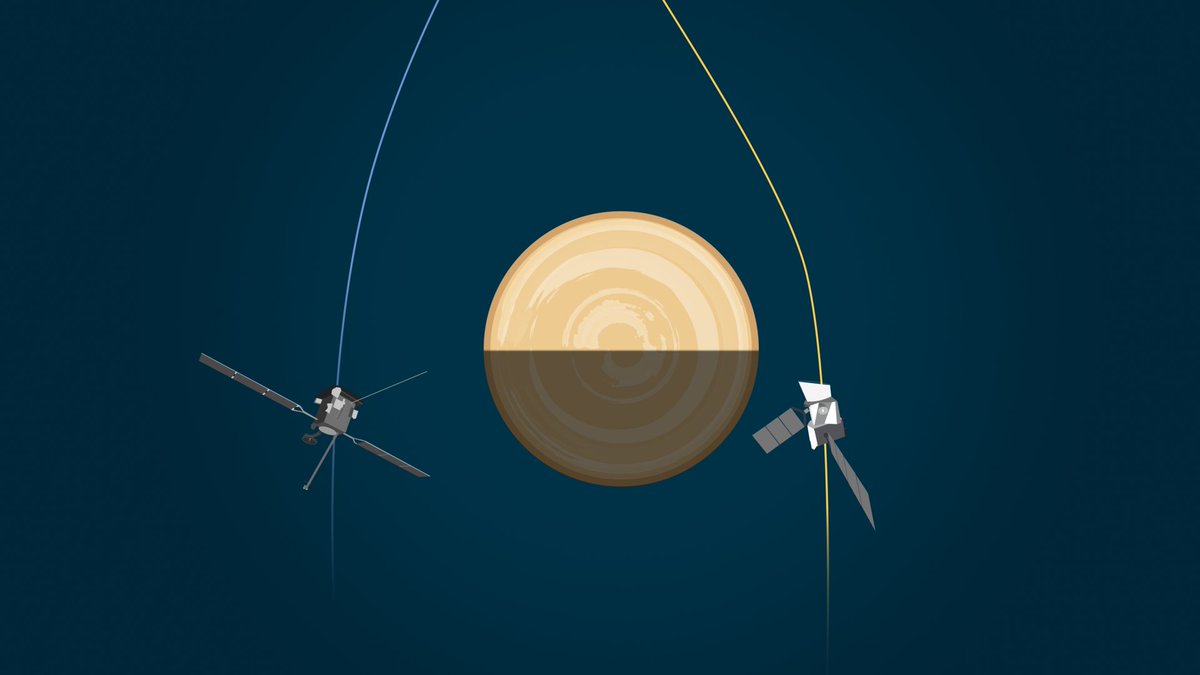

When Longfellow wrote about “ships passing in the night” back in 1863, he probably wasn’t thinking about satellites passing near Venus. He probably also wouldn’t have considered 575,000 km separation as “passing”, but on the scale of interplanetary exploration, it might as well be. And passing is exactly what two satellites will be doing near Venus in the next few days – performing two flybys of the planet within 33 hours of each other.
The two spacecraft in question are Solar Orbiter and BepiColombo. Neither is focused on the Venus system itself, but is simply using the planet for a gravity assist to get to their final destinations – the sun’s poles and Mercury respectively. It just so happens that they will be passing by our sister planet at around the same time.
This isn’t Solar Orbiter’s first merry-go-round with the planet, having used Venus as a gravity assist previously, and with potentially 6 more to go. All of those assists are to help the probe go where no machine has gone before – high enough above and below the sun to get clear images of its poles, where it hopes to get more information about the solar cycle.
BepiColombo, on the other hand, is on its second and final Venus flyby, though it still has plenty more assists from Mercury itself before it finally settles into a stable orbit in 2025. It will pass by Venus much more closely than its traveling companion, with an altitude of 550 km compared to 7995 km for Solar Orbiter.
Unfortunately, the distance between them is too great to expect a picture of one craft from the other. In fact, Solar Orbiter won’t be taking any visible light images of Venus this time around at all, as the probe must remain facing the Sun itself. BepiColombo won’t be able to turn its main camera toward the planet either, but two of its three “monitoring cameras” will be snapping as it goes past. In fact the spacecraft might also capture its own antenna and solar arrays in the picture. Though the pictures are only 1024×1024 resolution, they will be sent back to Earth gradually following the BepiColombo’s flyby on August 10th.
Other non-visual instruments on both spacecraft will be going full bore however. This would include Solar Orbiter’s SoloHI imager, usually used to image the solar wind, magnetic field sensors, and plasma sensors. In addition, there’s already a Venus orbiter in place around the planet – JAXA’s Akatsuki – which can collect additional data at the same time, allowing scientists to try to collate data points from many different physical locations as well as sensing modalities.
Close flybys like these are a great sideshow to the true science these orbiters will pursue once reaching their final destinations. It also provides a good warm up for them, and their handlers, to get the jitters out of their system. The fact that they happen to be passing by each other in such close succession on their journeys to their final destinations just makes it all the more interesting of a story.
Learn More:
ESA – ESA gets ready for double Venus flyby
spacewatch.global – Solar Orbiter and BepiColombo to make history with double Venus flyby
New Atlas – Venus will receive two visitors from Earth next week
S&T – TWO SPACE PROBES TO PASS BY VENUS NEXT WEEK
Lead Image:
Depiction of BepiColombo & Solar Orbiter passing by Venus in close succession.
Credit – ESA
Well that’s ruined all my lectures! I’ve spent years talking about space and a go…
According to Darwin, life on Earth may have first appeared in warm little ponds. This…
The habitable zone is where planets could have liquid water on their surfaces, but not…
Air travel produces around 2.5% of all global CO2 emissions, and despite decades of effort…
Researchers study enigmatic asteroid Kamo'oalewa, as China’s first asteroid sample return mission moves toward launch.…
In 2007, astronomers discovered the Cosmic Horseshoe, a gravitationally lensed system of galaxies about five-and-a-half…